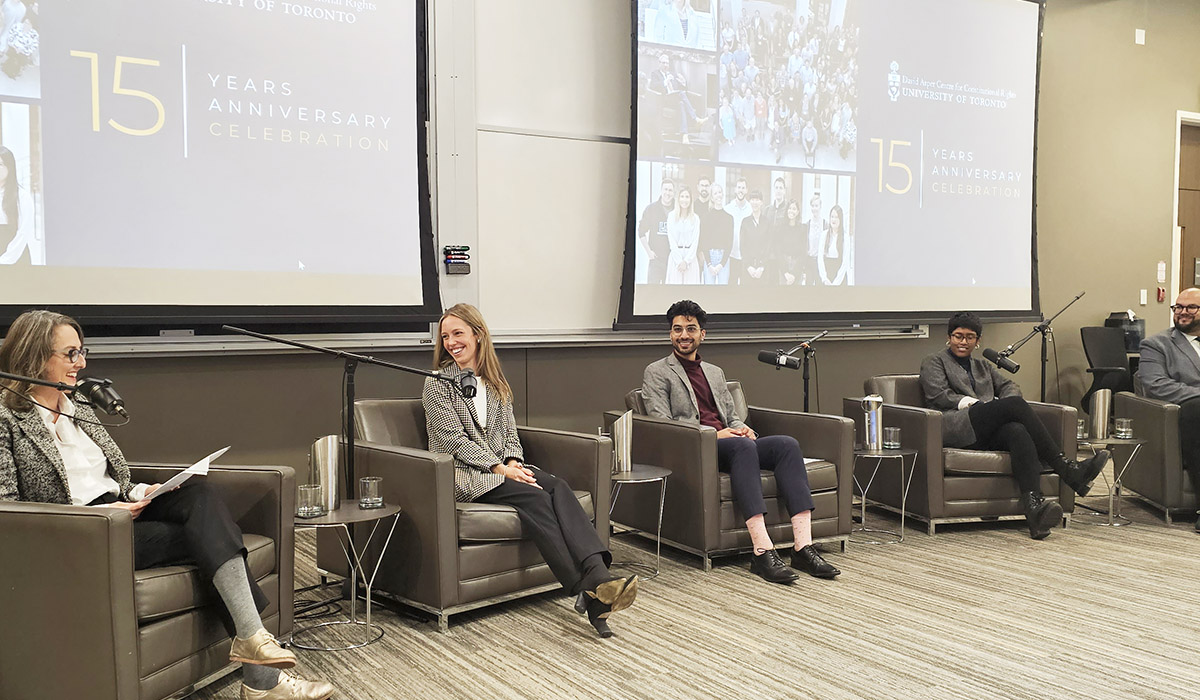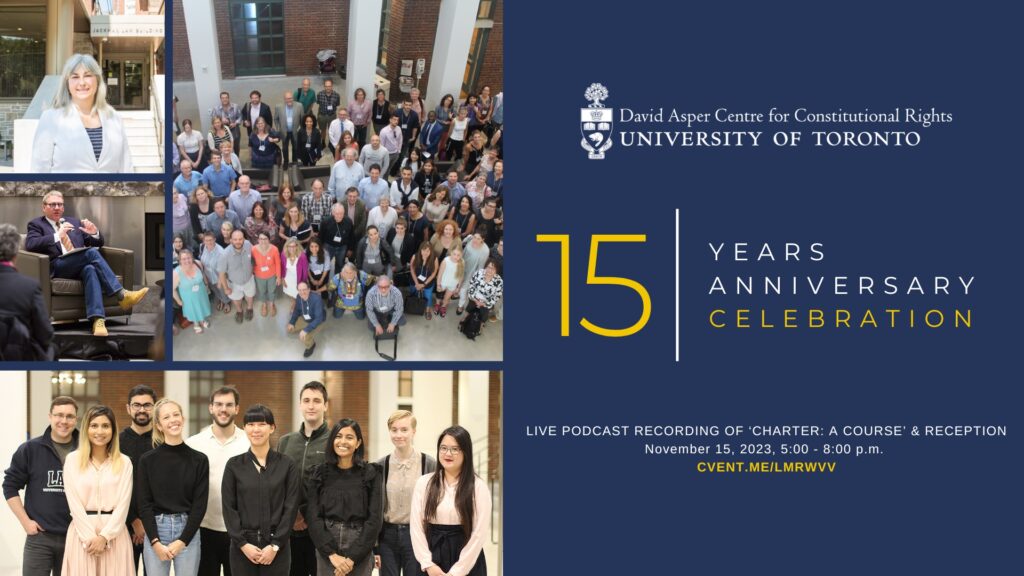by Kylie de Chastelain
Many students are fascinated by the constitutional issues they engage with in the classroom and the Asper Centre regularly receives questions about how to work towards a career in Constitutional law. To help address these questions, the Asper Centre hosted a panel discussion on February 12th, 2020, entitled: “Careers in Constitutional Law.”
Four brilliant lawyers were invited to share about their experiences in constitutional law practice. Emily Chan, a staff lawyer at Justice for Children and Youth, was joined by Sinéad Dearman, an Associate at Olthuis Kleer Townshend LLP; Geetha Philipupillai, an Associate at Goldblatt Partners; and Padraic Ryan, Counsel at the Constitutional Law Branch of the Ministry of the Attorney General of Ontario. Each panelist spoke about the realities of long-term litigation, working with rotating governments, and the complexities of constitutional law. The panelists’ career experiences are detailed below, followed by a round-up of their best advice for aspiring constitutional lawyers. As you’ll see, there’s more than one path towards working in constitutional law.
Emily Chan
Staff Lawyer, Litigation and Community Development, Justice for Children and Youth
Emily Chan’s day-to-day work is very diverse, ranging from privacy law to human rights matters and constitutional law issues. Her official title is “Community Development Lawyer” – a role which suits her passion for advocacy and community organizing. Initially, Emily never planned on having a litigation career; preferring research and writing to public speaking and debate. Despite this, litigation now comprises a significant portion of her practice.
Emily has represented Justice for Children and Youth before the Supreme Court of Canada on a number of interventions. Notable among these are Prime Minister of Canada v Khadr, 2010; an intervention about Omar Khadr and the rights of children who are found in armed combat overseas, and Kanthasamy v Canada, 2015; a case that considered the best interests of a minor who sought refugee protection in Canada on humanitarian grounds. Interventions such as these frequently involve Charter-based challenges – as was the case in Khadr, where Emily’s arguments on behalf of Justice for Children and Youth focused on Khadr’s section 7 Charter rights to life, liberty, and security of the person. Ultimately, Emily’s work – while not exclusively constitutional – does involve a significant amount of constitutional law; proof that a career in constitutional law doesn’t have to be “all or nothing.”
Sinéad Dearman
Associate, Olthuis Kleer Townshend LLP
Sinéad was called to the bar in 2018 and was a member of the Indigenous Law students Association while at the University of Toronto’s Faculty of Law. She works in child protection law and represents a variety of First Nations governments in matters relating to child welfare and custody. This work is demanding, and Sinéad spends approximately 75% of her time travelling to remote First Nations communities across Ontario, where she meets with band governments and stakeholders and represents them in child welfare cases. In addition to child protection work, Sinéad has appeared before the Canadian Human Rights Tribunal, suing the Canadian government for discriminatory underfunding in public services (see: First Nations Child and Family Caring Society of Canada v Canada, 2019). Sinéad also works in Indigenous law-making; helping First Nations to refine and uphold their legal traditions and advocating for their inclusion within the broader Canadian legal system.
Sinéad believes that in order to practice Indigenous law, and constitutional law more broadly, you have to be able to show up in “mind, body, and spirit.” The work requires more than intellect; it requires being present and involved beyond the law. For Sinéad, this has often meant being in ceremony with her clients and becoming involved in the community beyond what might be expected in a non-Indigenous lawyer-client relationship.
Geetha Philipupillai
Associate, Goldblatt Partners
Geetha was also called to the bar in 2018, and one month later found herself working on the high-profile case involving Premier Ford’s reduction of Toronto City Council seats (see: The City of Toronto v Ontario (Attorney General), 2018). Although Geetha does not generally practice in labour law, the case presented an opportunity to represent union clients with a vested interest in the structure of Toronto’s city council. It was valuable, she said, to have the opportunity to work on a constitutional case, even if it was not in a practice area she typically engages with. In general, Geetha’s day-to-day work at Goldblatt involves employment law, civil class action suits, and claims from LawPro; the company that provides Ontario lawyers with professional liability insurance. Geetha’s work with LawPro frequently involves defending lawyers against claims of negligence.
In addition to all of this, Geetha, who was an Asper Centre Clinic student, served as pro-bono junior counsel to the Asper Centre on the Morris intervention. This case is challenging criminal law sentencing with respect to systemic racism and specifically anti-black racism. The Asper Centre’s intervention focuses on the need for substantive equality in sentencing and the corresponding rights engaged by s. 15 of the Charter. For Geetha, working in constitutional law has meant making the most of the opportunities that come her way. Although her legal work is not exclusively constitutional, she has chosen to make this an area of focus in her career.
Padraic Ryan
Counsel, Constitutional Law Branch, Ministry of the Attorney General of Ontario
Padraic always knew that he was interested in constitutional law and litigation, and endeavoured to work in government jobs instead of full-service Bay Street firms as a result. As a member of the Constitutional Law Branch, Padraic’s work is exclusively constitutional. In essence, he supports branches of the ministry that have constitutional questions or claims before them. Typically, these claims relate to statutes or policies that are being challenged, and while Padraic’s work involves a significant amount of litigation, he also provides advice to government ministries facing this kind of claim.
The work is full of variety, and Padraic says that one of the best parts of his job is the constant learning. In this kind of work, you never feel as though you’ve “specialized” or “mastered” a particular area of law – instead, you’re constantly learning about statutes you never knew existed and consulting with government ministries across a broad range of practice areas. By way of example, Padraic says he has worked on fire code prosecutions, labour relations issues, and interventions relating to federal immigration law. The challenges of government work are ever-present, he says, and dealing with election cycles, changing governments, and funding constraints can make his job very interesting. For those interested in a diverse range of legal issues that all engage constitutional law, a government position like Padraic’s might be the perfect fit.
Career Tips for Aspiring Constitutional Lawyers
- Take a variety of courses. Emily advises that you take a variety of courses while you’re in law school because constitutional questions can arise in “any area of law.” Having a bit of knowledge across practice areas is helpful, because you simply can’t anticipate all the areas of law you might end up working in. Emily pointed to her own experience, noting that although she doesn’t practice refugee and immigration law, much of her constitutional work has involved Charter-based advocacy for refugee children and youth. Having the legal context that comes from a bit of coursework experience is highly valuable.
- Have a demonstrated interest. All the panelists agree that, when it comes to hiring, it’s nice to see an applicant with a clear interest or passion. Whether it’s through your extra-curriculars, course selection, non-law school activities, or the organizations you belong to, make sure to highlight what you are interested in. Padraic emphasized that this doesn’t mean you must do every single extra-curricular related to constitutional law; but it’s good to be able to show participation in at least one or two constitutionally-related activities if this is something you are hoping to practice later on. The Asper Centre offers some fantastic ways to get involved, including: The Constitutional Law Clinic, Student Working Groups, and Summer Fellowship Program.
- Consider administrative law. Geetha and Padraic suggest that administrative law is a great area of focus for constitutional-law hopefuls. Administrative law contains many of the same legal themes as constitutional law, and has the advantage of being highly marketable in the legal world. Geetha emphasized that administrative law can also be useful in practice because often constitutional challenges are brought by people who are unable to finance protracted litigation. When you understand administrative law well, you are better able to advise clients as to their strategic options and help them to achieve their goals without engaging in costly litigation.
- Remember that your law practice will likely be diverse. With the exception of Padraic, who works in a role exclusively devoted to constitutional law, none of the panelists focus solely on constitutional work. Instead, constitutional law is simply one of many practice areas they engage in. Remember that it is rare to find a full-time job in constitutional law. Instead, think about adjacent practice areas that you are passionate about, and jump at the chance to do constitutional work when you can.
- Don’t worry if the path isn’t straight. Sinéad says that while law school can be challenging intellectually, mentally, and emotionally, do your best to stick with it. Remember that law school and legal practice look very different, and being a young lawyer is nothing like being a young law student. Rely on the routines and activities that make you feel good and give you a sense of meaning beyond law school, and try not to get caught up in comparison and competition. As Padraic says, it’s better to think about the kind of work you want to do, and where you think you’ll fit best career-wise than to spend time trying to “check boxes” for the sake of it.
Kylie de Chastelain is a 1L student of law at the University of Toronto and the current Asper Centre work-study student.


